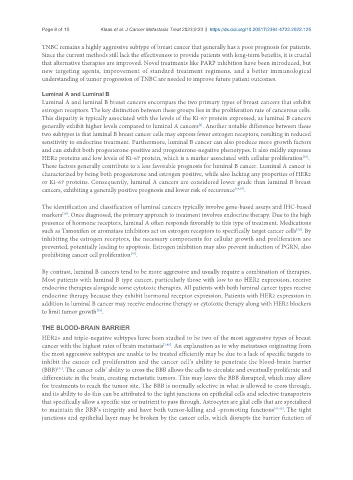Page 434 - Read Online
P. 434
Page 8 of 15 Klaas et al. J Cancer Metastasis Treat 2023;9:23 https://dx.doi.org/10.20517/2394-4722.2022.125
TNBC remains a highly aggressive subtype of breast cancer that generally has a poor prognosis for patients.
Since the current methods still lack the effectiveness to provide patients with long-term benefits, it is crucial
that alternative therapies are improved. Novel treatments like PARP inhibition have been introduced, but
new targeting agents, improvement of standard treatment regimens, and a better immunological
understanding of tumor progression of TNBC are needed to improve future patient outcomes.
Luminal A and Luminal B
Luminal A and luminal B breast cancers encompass the two primary types of breast cancers that exhibit
estrogen receptors. The key distinction between these groups lies in the proliferation rate of cancerous cells.
This disparity is typically associated with the levels of the Ki-67 protein expressed, as luminal B cancers
[1]
generally exhibit higher levels compared to luminal A cancers . Another notable difference between these
two subtypes is that luminal B breast cancer cells may express fewer estrogen receptors, resulting in reduced
sensitivity to endocrine treatment. Furthermore, luminal B cancer can also produce more growth factors
and can exhibit both progesterone-positive and progesterone-negative phenotypes. It also mildly expresses
[36]
HER2 proteins and low levels of Ki-67 protein, which is a marker associated with cellular proliferation .
These factors generally contribute to a less favorable prognosis for luminal B cancer. Luminal A cancer is
characterized by being both progesterone and estrogen positive, while also lacking any properties of HER2
or Ki-67 proteins. Consequently, luminal A cancers are considered lower grade than luminal B breast
cancers, exhibiting a generally positive prognosis and lower risk of recurrence [18,37] .
The identification and classification of luminal cancers typically involve gene-based assays and IHC-based
markers . Once diagnosed, the primary approach to treatment involves endocrine therapy. Due to the high
[38]
presence of hormone receptors, luminal A often responds favorably to this type of treatment. Medications
[39]
such as Tamoxifen or aromatase inhibitors act on estrogen receptors to specifically target cancer cells . By
inhibiting the estrogen receptors, the necessary components for cellular growth and proliferation are
prevented, potentially leading to apoptosis. Estrogen inhibition may also prevent induction of PGRN, also
prohibiting cancer cell proliferation .
[10]
By contrast, luminal B cancers tend to be more aggressive and usually require a combination of therapies.
Most patients with luminal B type cancer, particularly those with low to no HER2 expression, receive
endocrine therapies alongside some cytotoxic therapies. All patients with both luminal cancer types receive
endocrine therapy because they exhibit hormonal receptor expression. Patients with HER2 expression in
addition to luminal B cancer may receive endocrine therapy or cytotoxic therapy along with HER2 blockers
[38]
to limit tumor growth .
THE BLOOD-BRAIN BARRIER
HER2+ and triple-negative subtypes have been studied to be two of the most aggressive types of breast
cancer with the highest rates of brain metastasis [7,40] . An explanation as to why metastases originating from
the most aggressive subtypes are unable to be treated efficiently may be due to a lack of specific targets to
inhibit the cancer cell proliferation and the cancer cell’s ability to penetrate the blood-brain barrier
[41]
(BBB) . The cancer cells’ ability to cross the BBB allows the cells to circulate and eventually proliferate and
differentiate in the brain, creating metastatic tumors. This may leave the BBB disrupted, which may allow
for treatments to reach the tumor site. The BBB is normally selective in what is allowed to cross through,
and its ability to do this can be attributed to the tight junctions on epithelial cells and selective transporters
that specifically allow a specific size or nutrient to pass through. Astrocytes are glial cells that are specialized
to maintain the BBB’s integrity and have both tumor-killing and -promoting functions [41,42] . The tight
junctions and epithelial layer may be broken by the cancer cells, which disrupts the barrier function of

